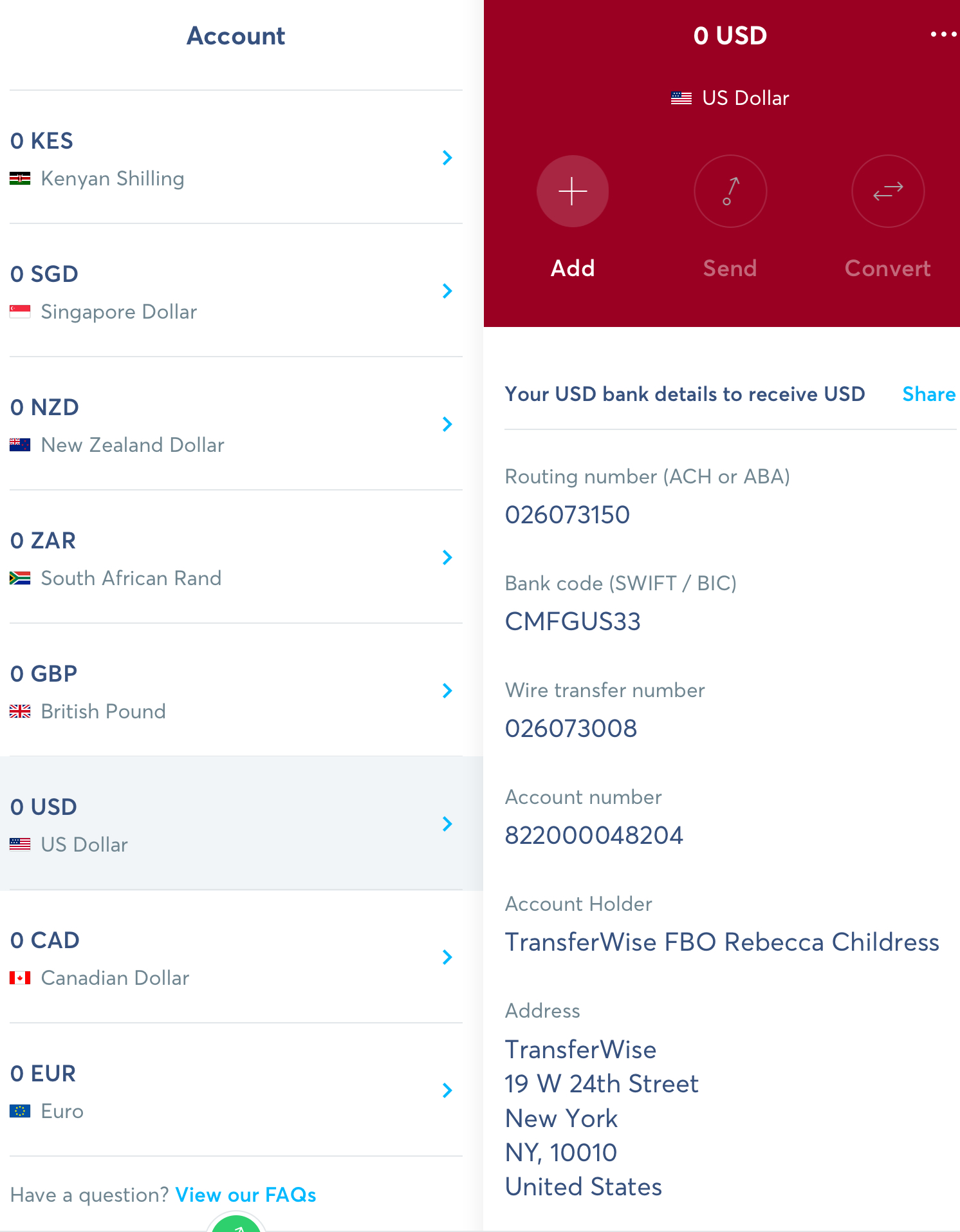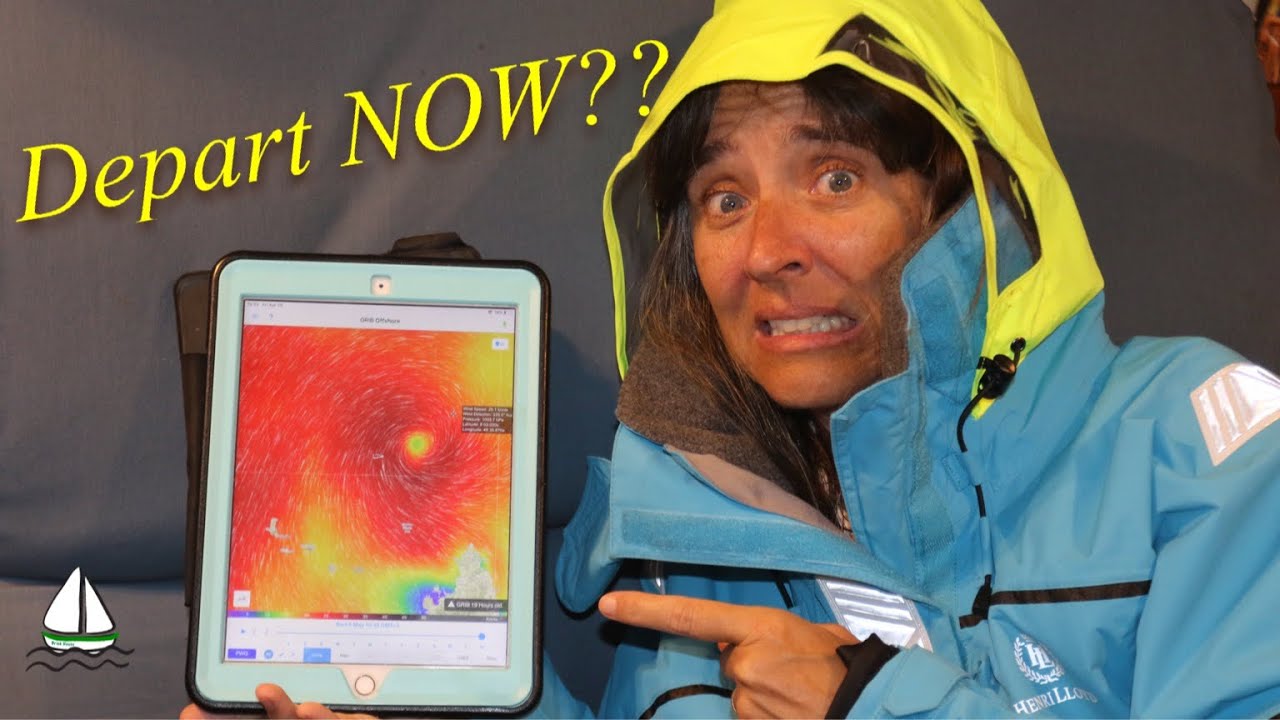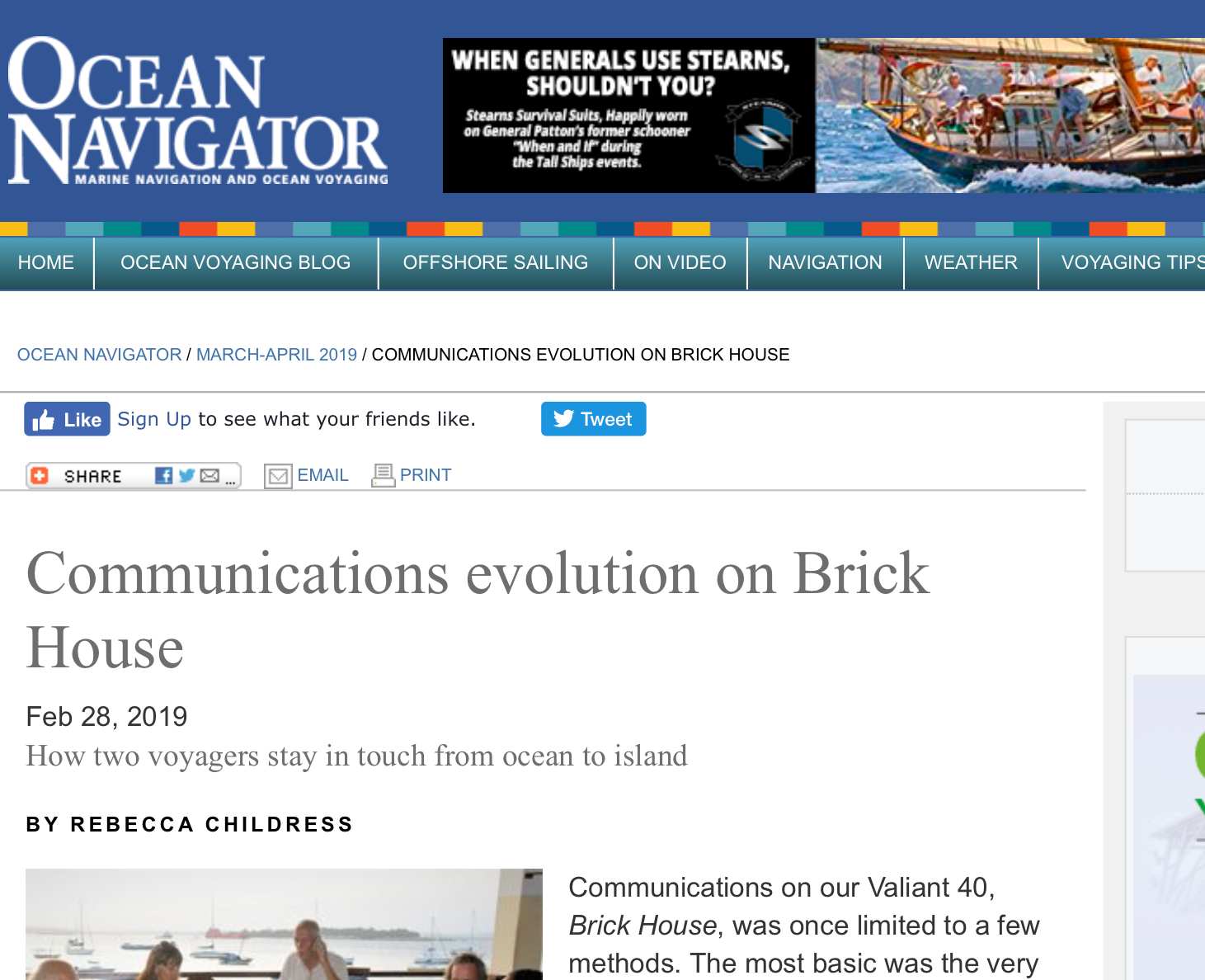Communication Evolution on Brick House : Iridium GO! Predictwind!
My latest article in Ocean Navigator Magazine reprinted below. See the Original Article at Ocean Navigator..
Communication on our Valiant 40, Brick House, was once limited to a few methods. The most basic was the very high frequency (VHF) radio used for short-range communications to other boats and shoreside facilities. Single sideband (SSB) radio chat nets were used while underway and from remote anchorages to talk to cruisers at distances over the horizon.
The SSB radio, coupled with a device called a Pactor modem gave us the ability to send and receive text email messages through the software services SailMail and Winlink when the atmospheric propagation was agreeable. We had to train friends and family to keep messages short and without attachments that could easily overwhelm the delicate pipeline of radio waves. Sometimes in port, a hotel or yacht club would offer Wi-Fi, which would be usable on board if we could anchor close enough to the signal. Eventually we installed a Redport Long Distance Wi-Fi Extender on the stern arch so we didn’t have to anchor nearly on the beach.
The SSB was once the primary long-range communications device. Life on board was dictated by propagation tables that spelled out optimum connection times, calculated by the state of the ionosphere, and the distance between stations. Happy hours and barbecues were abruptly interrupted as cruisers raced back to not miss checking into SSB nets or for their turn at being net controller, while others jockeyed for their turn at modem connections.
To make sure both SSB/Pactor and voice communications worked reliably, monthly maintenance demanded copious cleaning of corrosion between the antenna, ground connections, tuner, radio and modem. But in those not-so-primitive times, it was our only option.
 |
|
Brick House’s radio gear: an HF SSB, a PACTOR radio modem and a VHF.
|
|
Growth of cellular
Over time, cellphone connectivity became more accessible because a forest of cell towers went up everywhere, even in the remote islands of Fiji. Competition drove prices down. Natives who lived in thatch huts would row up in rough carved canoes, handing their phones over, asking for a battery charge. At times, we had adventures hiking to a high pinnacle to get a signal from a tower on the next distant island.
In cruising Southeast Asia, we found cellular Internet had become even easier and less expensive. Communication between cruisers, businesses and those half a world away took a big leap forward. Our smartphone became a Wi-Fi hot spot for connectivity on board and the Internet handled all communications. The VHF, SSB and Pactor began collecting dust and rust.
Though Internet had become more accessible, there was often a learning curve to understanding the system in each country. Smartphones in the U.S. are often sold as “locked,” but cellphones internationally are mostly sold as “unlocked” and can use SIM cards from any country, costing only a dollar or two. Now upon arrival to a new country, it has become top priority to visit a cellphone store with phone and required passport so that we can leave with connectivity pronto.
We needed then, to learn how to put more “load” or “credit” on the phone — usually with scratch cards or by visiting almost any store — and then learn how to buy an Internet plan, usually by punching a series of numbers and pound signs into the phone. Every country has slightly different procedures and little gotchas to learn so as to preserve your data. In the past year, in almost every country we visit now, they have even come out with apps to automate the whole process.
 |
|
The Childresses’ boat is also equipped with an Iridium GO!
For more information and to Buy the Iridium GO, Click here…
For the external antenna I recommend for the Iridium GO, Click here
|
| The Weather Program we recommend:Weather |
From an energized cellphone, the beeps and dings of Messenger, WhatsApp and email notifications fill the air on board. The notifications are usually from other cruisers, so leaving the annoying VHF turned on and listening to endless impertinent VHF chatter is a thing of the past. SSB nets began their decline in Southeast Asia simply because everyone was connected by cellular, and SSB radios faded away for all but the most dedicated operators. Cellular remains the number-one most utilized communication method in port and for coastal sailing.
But when the Indian Ocean loomed on the horizon, it was time to get suited back up for long-distance remote connectivity. First, I should say, for a while in the remote Pacific, we did have an Inmarsat satphone on board in case of an emergency. It was such an expensive communication device to operate, full of billing surprises, so we hardly used it. We knew this would not be an ideal way to cross the Indian Ocean, being reluctant to use it to get weather reports for extended intervals. We then made the single most drastic change that we have ever made to how Brick House communicates: We sold the Inmarsat satphone to help pay for our new communication system, an Iridium GO Marine Package from PredictWind. This is robust satellite communications.
Switching to satcom
We no longer use the SSB radio/Pactor setup for email or weather — ever. It has nearly gone the way of the cassette player or radio direction finder. We still maintain the SSB, however, just in case. If I were to put money into a backup system now, it would be to have a second Iridium GO. A cruising friend did exactly that but sold it three years later because the original one just never skipped a beat.
The installation of the Iridium GO was like any other electronic device: a 12-volt power source and an antenna on the stern arch. We mounted the antenna as high on the arch as possible to have a clear view to the Iridium satellites, and above the radar dome more than 6 feet from the wind generator to avoid physical and electronic interference. We had to empty lockers to clear the way to snake a rather monstrous cable through small holes without bending it. We permanently mounted the Iridium GO’s gray box near the chart table in a position that would not be in direct sunlight, not incur accidental splashes or bumps, and most importantly would receive a steady GPS position. The small hinged antenna on the unit not only turns the unit on but gets the GPS position as well — just not the Iridium satellites when the external antenna is attached. Many cruisers who don’t have the external antenna have to take the gray box outside and hope it doesn’t fall in order to get a semi-acceptable transmission.
 |
|
The Childresses use Xgate to manage their email usage.
|
The GO ships with a common automotive 12-volt plug for power. Since the GO is powered via a common USB mini-B five-pin connector, I took the automotive plug side off and hardwired it in to a Wagan smart USB charger. This device is powered via 12V, and then steps down and autosenses the amperage needed to safely charge each device that is plugged in to its four USB outlets, providing up to 9.6 amps. I installed a manual one-hour timer in the circuit so I can wind it up to charge, and then it automatically shuts down to prevent constant powering of the sensitive batteries.
It’s very important to update the firmware upon receiving the unit and watch for subsequent updates, as well as obtain updates for the GO software used on the devices. There appears to be nothing more to maintain aside from keeping the electrical connections tight and corrosion free.
With the Iridium GO and PredictWind’s no-contract unlimited data plan, we have easy access to impressively accurate forecasts using Predictwind Offshore. We are able to send and receive our emails as many times a day as we wish, at any time, in any weather, along with texts to our friends and other Iridium users. We have 150 minutes a month of actual phone calls. So now we can communicate anywhere in the world, anytime, whether it be with family or businesses here, or in the next country for marina reservations, to order needed parts or for technical support to keep our boat operating. We can even get a webpage if we don’t mind waiting. The system is somewhat expensive at $139 per month with an initial setup cost of approximately $1,000, but for someone with business interests, the system could quickly pay for itself by nipping a problem in the bud. And, of course, this is a tremendous emergency communication device.
FREE Predictwind Offer
Email considerations
Our email setup with the Iridium GO software is a little more complex than many users’ setup due to the volume of emails that we get, which is easily in the hundreds every day. Some people have an “at sea” address and an “on land” address, but we have just one primary email address that covers land and sea so we never miss an email.
First, I will tell you the two requirements that led to having the complexity (yet the simplicity) of just one email address.
- I could not afford to miss a single email, large or small, because of having two email addresses, and I needed to have full capabilities on both my tablet and laptop whether at sea or on land.
-
I planned to shut off the GO service when I was in port, yet I needed to access/send/receive all emails that I had access to while at sea and continue to have that access on land — and vice versa. I needed one application on all devices to send and receive email from anywhere.
The solution? XGate software was installed on my iPad, smartphone and laptop. XGate does it all: connecting to the Iridium GO, the SSB/Pactor or to regular Internet, accessing all of my email and keeping it synced between devices. I can access both new and old emails on any of the devices in the same application with any kind of connection, on land or at sea.
I have all of my email forwarded to my XGate account — not my Iridium Mail account — and XGate then automatically transmits the short emails. It then sends a list of “large” emails to a folder called “BigMail” (in my case, I chose “large” to be larger than 30kb). I can then decide from that folder which emails I want to receive. I can do this from any device with any connection. I also set up a number of keyword filters to eliminate email that I don’t want at sea, such as Facebook notifications or Dell computer sales.
 |
|
XGate email management options allow Childress to set the inbound email cutoff size and to mass delete emails.
|
Note: Some systems, like Yahoo, do not allow forwarding of all emails, and fetching is not recommended in most situations. I will provide a more technical explanation and solution to this scenario on my blog at www.WhereIsBrickHouse.com.
Unless you plan to leave the Iridium GO activated for long stays in port and use it regularly, you cannot access email in the Iridium Mail app or online since it’s only accessible by satellite. XGate not only makes my mail accessible by satellite or Internet, but it does it all in the same application. If two months of email are allowed to get backed up in an Iridium Mail address that can only be retrieved by satellite, there will be a problem. Iridium Mail offers no tools to remedy this case or any other problem, and Iridium offers no technical support, help line or contact information. Using XGate, however, I can simply boot up the laptop where heavy-duty XGate tools reside, and many of the problems are resolved. Reparation at sea becomes quite plausible. There is even a human being on the other end of the phone or email to help since GMN, the makers of XGate, are actual human beings standing by to help. And, of course, support is second to none, though your Iridium Mailbox is not accessible to them either.
There was something salty about the old days of anticipating a chat session with other cruisers on a schedule over the SSB and having little, if any, email at sea — just simple solitude. Sadly, everyone now seems to be glued to their cellphones, on the boat and on land. Cruisers sit at the yacht club, sipping wine, overlooking the anchorage, and all of them are staring at a screen. Maybe they are in a trance, gazing at my husband Patrick’s YouTube Channel.
Rebecca Childress and her husband Patrick Childress, have a long history of sailing behind them, but most recently they have been cruising the world for 12 years and are in Tanzania en route to South Africa, on their 1976 Valiant 40 Brick House. In addition to their long-standing blog at www.WhereIsBrickHouse.com, Patrick has started a new YouTube channel, www.youtube.com/PatrickChildress.
Subscribe to Ocean Navigator herehere…one of our most favorite sailing magazines!
Advertisements


Indian Ocean Crossing, The Preparation
What I did to make my SSB Radio and Pactor Modem work properly…more than 11 years ago…
Magazine Articles by Patrick Childress/Rebecca Childress in Sailing Publications
Related Images:
Like this:
Like Loading...
 Finally, American Cruisers can have a SWIFT bank code too.
Finally, American Cruisers can have a SWIFT bank code too.









